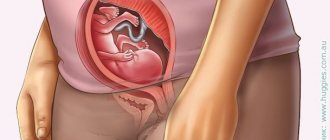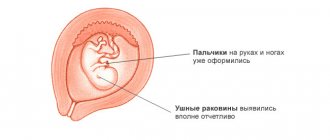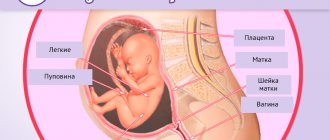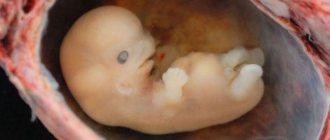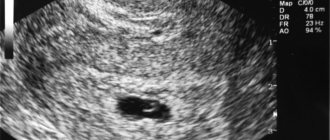If one baby is growing in your belly, it means that at exactly thirty weeks you received “exemption” from work for the next 140 days, which is the period for which a certificate of incapacity for work is issued.
Now you will have more free time, which you can spend on yourself and your future baby.
It's time to realize everything you've planned - tie the baby's dowry, go shopping, collect a first aid kit, buy a stroller and much, much more.
This doesn’t mean at all that you have to do renovations in the apartment or general cleaning yourself - just enjoy yourself, relax, it’s unlikely that you will be able to do this after giving birth.
Fetal development
The baby in the mother’s womb becomes cramped, his movements are constrained, more rare, but strong.
This is what your baby looks like at 31 weeks
The fetus continues to gain weight, because in the remaining time it needs to grow at least another 1000 to be considered full-term and mature.
The baby reacts to light, which becomes clear from the increase in activity when bright light hits the mother’s belly.
Subcutaneous fiber evens out skin color, making it less red and more natural.
The nervous system continues to mature and develop, convolutions and grooves are formed in the cerebral cortex, nerve fibers are covered with a protective sheath, which significantly increases the speed of impulses passing through them.
The production of surfactant in the lungs continues, but it is not yet enough for independent breathing - the baby is too early to be born.
The liver is preparing to perform its functions, its structure becomes more perfect, and liver lobules are formed. The number of cells in the pancreas increases significantly; immediately after birth, its secretion will participate in the breakdown of proteins, fats and carbohydrates.
The nails grow and almost reach the tips of the fingers, the hair on the head becomes thicker. But the vellus on the body gradually falls out.
Recommended lifestyle for a pregnant woman
The third semester has its own contraindications regarding the movements of a pregnant woman. If a plane flight is planned for this time period, then it is better to refuse it for the following reasons:
- possible manifestation of varicose veins due to fluctuations in atmospheric pressure;
- probable fetal hypoxia or partial placental abruption due to the same reason.
Meals at 31 weeks of pregnancy should be frequent and small. Due to the strong pressure of the uterus on the organs of the gastrointestinal tract, it is worth excluding from your diet those foods that contribute to increased gas formation - these are: legumes, cabbage, bread and carbonated drinks.
Don't forget about vitamins. It is better to leave the selection of vitamin-mineral complexes to your attending physician, who will do this competently, based on test data showing which vitamins the pregnant body lacks.
Many people wonder: is it possible to have sex at 31 weeks of pregnancy, is it dangerous? You can have sex, but it is recommended to do it with extreme caution due to the physiological characteristics of women. Gentle, leisurely sexual intercourse, on the contrary, will even bring benefits: the woman will be able to relax and temporarily stop thinking about any problems associated with pregnancy tolerance.
Attention! We can talk about having sex only in cases where factors such as carrying twins or the risk of premature birth are excluded.
By the way, the following actions will help alleviate the condition:
- rubbing the back and lumbar region, as well as massage of the arms and legs;
- cool foot baths;
- wearing compression stockings and a special bandage.
Ultrasound at 31 weeks of pregnancy
It is possible that you will be scheduled for your third and final scheduled ultrasound this week.
If during the last study the baby was shy and did not show you his gender, you can find out everything this time. The specialist, according to the protocol, will take all the necessary measurements, rule out organ malformations, measure the heart rate and the amount of amniotic fluid.
Already at this time it is possible to detect malformations of the gastrointestinal tract and genitourinary system. It is mandatory to assess the condition of the placenta and blood flow in it. The condition of the uterus, wall thickness, muscle uniformity are also assessed, the length of the cervix, and the degree of opening of the cervical canal are measured.
Is it necessary to perform an ultrasound?
During this period of pregnancy, the woman may be prescribed a third planned ultrasound examination. An ultrasound examination at 31 weeks of pregnancy will be an excellent opportunity for the expectant mother to monitor her baby. During the ultrasound examination, you can ask the doctor to take a photo of the baby at 31 weeks of pregnancy.
During an ultrasound session at 31 weeks of pregnancy, a specialist will measure the size of the baby and assess its compliance with the gestational age, examine the baby’s internal organs and assess the degree of their development. He will also listen to the baby’s heartbeat and rule out the development of pathologies and anomalies in the baby.
The doctor must evaluate the size and condition of the uterus, pay attention to the amount and nature of amniotic fluid, excluding oligohydramnios or polyhydramnios during pregnancy 31 weeks. The condition of the placenta, its location and attachment in the uterus are examined separately.
What happens in your body at 31 weeks?
Not only your baby changes, but your entire body changes:
- the stomach grows due to the enlargement of the uterus (its bottom is now located 11 cm above the navel), as well as due to the deposition of fat in the lateral parts;
- the amount of amniotic fluid increases to a liter, this is quite enough to protect the baby from compression by the uterus and injury - water plays the role of a protective buffer;
- weight gain this week will average about 9.5 kg;
- under the influence of the hormone relaxin, the pelvic bones expand - they are preparing to let your baby into the world;
- excessive weight gain and increased swelling may indicate that it is very difficult for the kidneys to cope with the load, and without support they may simply fail, so do not hide your true weight from the doctor, especially if the increase is significant;
- a frequent companion of a pregnant woman is candidiasis, which occurs due to decreased immunity/
Woman's feelings
By the 31st week, a woman has time to experience not only all the delights of pregnancy, but also all its hardships. There is no longer the former ease; simple everyday tasks are difficult. A woman gets tired faster and may be tormented by various pains. All systems of the body begin to “tune in” to the imminent birth, and everything that happens to the baby and mother at this time is, in one way or another, connected precisely with this advance preparation.
Fetal movements
The beginning of the 31st week is usually marked by a decrease in the baby’s motor activity. The baby becomes cramped, there is less and less free space in the uterus, now the baby can only move his head and limbs without any problems. Complete inversions are already limited by the walls of the uterus; they are practically impossible.
At the same time, the movements become stronger, the woman sometimes feels painful kicks and pokes. If the baby is in a breech position, movements are more often felt in the lower abdomen, and women can easily determine where the baby’s head is, where the butt is, where the legs and arms are.
The baby obeys his daily routine. He, of course, spends most of the day sleeping. Periods of wakefulness may not coincide with maternal periods. Wiggling has long ceased to be ordinary movements; now it is the language of communication between a mother and her child. The baby begins to move more actively if he lacks oxygen and nutrition, if the mother has taken an uncomfortable position. Often babies “knock” on their mother’s palm, which is specially placed on their stomach. By the nature of the movements, the mother guesses about the well-being of her baby.
The baby exhibits high meteosensitivity. On clear days it is more active than on cloudy and rainy days. It is also directly affected by the mother’s emotions. If a woman is happy, she rejoices, the baby receives the joy hormone and becomes active. If a woman is sad, worried, or under stress, the baby receives stress hormones and reduces activity.
Despite the cramped living conditions, the baby still continues to demonstrate its character. An active and curious baby moves in the womb more often and more strongly than a calm baby who prefers to sleep.
A woman should definitely take all these factors into account when calculating the movements that she should do daily at 31 weeks.
How to count movements?
At week 31, data on fetal movements is recommended to be entered into a special table, which is given at the antenatal clinic. If they didn’t give it to you, you can draw it yourself or download and print it.
Counting movements is necessary in order to get the most complete picture of the baby’s condition, because any problem immediately affects his motor activity.
When counting, women often make the grave mistake of considering each movement as separate. Before you start making calculations, you need to remember that one movement is both a single movement and a whole series of movements. If the baby turned over and then “kicked” the mother with his heel, this is one movement. If the baby simply “kicked” the mother, and this was not followed by another movement, then this is also one movement.
For counting, you can use any of the existing methods. The most popular is the Pearson method , which is popularly called “Count to Ten”. Counting begins at 8 or 9 o'clock in the morning. As soon as the woman mentally records the tenth movement, she notes in the table the time at which it occurred and does not return to counting until the end of the day. If before 21 o'clock, if the counting began at 9 am, or before 20 o'clock, if the woman started counting at 8 am, the baby demonstrates 10 movements, everything is fine with him.
The Cardiff method is also quite widespread among pregnant women. It differs from Pearson only in that the woman herself chooses when to count the movements. If her fetus is more active at night, she may well count the movements at night, the main thing is that the baby also demonstrates 10 movements in 12 hours.
is less common . But it can also be used - either separately or in addition to the Pearson or Cardiff method. A woman should record movements after eating. If after a delicious dinner the baby kicks 4 or more times within an hour, there is no reason to worry.
Counting movements allows a woman to quickly know that the baby is experiencing difficulties. For example, if the umbilical cord is entwined around the neck, the Rh conflict has entered the active stage, pathologies of the placenta have arisen, the baby may be at risk of hypoxia. Oxygen starvation is dangerous due to irreversible processes in the brain: lack of oxygen injures the nervous system of the fetus. Hypoxia is a common cause of intrauterine fetal death.
If your baby suddenly becomes more active, his movements become chaotic, frequent, painful and restless, the initial stage of hypoxia cannot be ruled out. With severe and prolonged hypoxia, children, on the contrary, reduce physical activity in order to “save” oxygen. A woman may not be able to count the required number of movements.
If there is a deviation from the norm in one direction or another, a woman must inform her doctor about it. At this stage, his diagnostic capabilities are wider - now he can prescribe CTG (cardiotocography) in addition to Doppler ultrasound, which will determine the speed of blood flow in the uterine vessels.
In case of hypoxia, which poses a threat to the life and health of the baby, early delivery by cesarean section may be recommended.
The mood of the expectant mother
The mood of a pregnant woman at 31 weeks again becomes dependent on hormones. If in the early stages changes in the psychological state were “dictated” by progesterone, now estrogen influences the woman’s psyche. The closer to the due date, the more of these hormones are produced in the body. They contribute to increased anxiety and suspiciousness, and the emergence of fears.
Most often women this week complain about fear of childbirth. It can be so strong that a woman cannot think about anything else. It would seem that one should be happy about meeting the baby soon, but nothing makes the woman happy, and the more materials she reads about how childbirth proceeds, the stronger this fear becomes.
This fear is considered normal, and psychologists recommend that pregnant women learn to cope with it so as not to darken the last months of pregnancy for themselves or for the child, who is already sensitive to the mother’s mood swings. In addition to the fear of possible pain, women are at a loss about the condition of the child. Even if the ultrasound showed no abnormalities, every expectant mother from time to time has the thought that she may give birth to a sick baby.
In addition, women in the third trimester worry about their relationship with their husbands, because there is almost nothing left of the waist, and clumsiness and weight gain are not conducive to active and easy sex. Women are afraid to give birth prematurely, not to get to the maternity hospital, they are afraid that they will have a caesarean section. All fears can and should be fought.
Psychologists recommend not reading about complications and difficulties during childbirth, and stop communicating with people who talk about their own or others’ negative experiences of childbirth. Instead, it is better to focus on the pleasant things - buying baby clothes, toys, a stroller and a crib. And specialists will help you prepare for childbirth without unnecessary nerves at courses for pregnant women, where it’s time to enroll if this has not been done before. There they will teach you how to breathe and push, and talk about the first signs of labor.
If at 31 weeks a woman cannot cope with her emotions, she is overcome by anger, she is excessively tearful, you can consult a psychologist, who can see you for free at any antenatal clinic.
Mild pain is considered completely normal for this period, because the uterus has become large, the ligamentous apparatus has been stretched, and the load on the spine, muscles, and lower limbs has increased. Such pains do not indicate the onset of labor and you just need to come to terms with them, because now they are unlikely to leave the woman until the very moment the baby is born.
The onset of premature labor at 31 weeks is indicated by the following symptoms:
- cramping pain in the lower abdomen, intensifying over time, repeating at certain intervals;
- rupture of amniotic fluid;
- the appearance of bloody discharge from the genitals.
All other pains are considered physiological and should not greatly disturb a woman. A displaced center of gravity due to a large belly causes tension in the ligaments, muscles and lumbar spine. As a result, the back hurts and the lower back is strained. The longer a woman is forced to remain in an upright position, the stronger the pain becomes. But they are not acute; rather, they can be described as dull and aching.
The pregnant woman’s body began to produce relaxin several weeks ago. This hormone relaxes and softens the ligaments and bones of the pelvis. This is how the small pelvis prepares for childbirth. These processes lead to pain in the pubic bone.
You will have to endure the unpleasant sensations. But if the pain in the perineum becomes acute and unbearable, if the pain between the legs is so severe that a woman cannot sit or stand, walk, climb stairs or roll over from side to side, she should definitely consult a doctor. This is how symphysitis manifests itself - a dangerous complication primarily because natural childbirth can lead to a woman’s disability. Often, when symphysitis is established, a cesarean section is performed.
Night leg cramps are a consequence of a lack of calcium in the mother's body. The baby’s bone skeleton continues to grow, and the bones become stronger. For the same reason, a woman’s nails may become brittle. If your tooth starts to hurt, you can now go to the dentist: most painkillers are already allowed. However, treatment is complicated by the inability to take an X-ray of the tooth.
Aches in the knees and ankles at 31 weeks are a natural consequence of significant weight gain.
Headaches are associated with a heavy load on the blood vessels and heart, as well as changes in blood pressure.
If your headache is severe and frequent, you should definitely consult a doctor, because hypertension, like hypotension, is not the best companion for pregnancy in its third trimester.
Discharge from the genital tract
Be sure to continue to monitor vaginal discharge.
Minor bleeding on panties appears when the mucous membrane is injured, as well as with hemorrhoids. Blood in large quantities is an alarming symptom and may indicate the onset of labor, placental abruption, especially if combined with painful sensations, or appears after a blow to the stomach, heavy loads or sudden movements.
The appearance of green, yellow, foamy or flaky discharge with an unpleasant odor indicates the development of an infection and requires immediate treatment - the baby must pass through a clean birth canal, and there is not much time left before birth.
Copious watery, odorless discharge with a yellowish tint can be amniotic fluid and appears when the membranes are torn or completely ruptured. If a pregnant woman suspects such a condition, there is no need to hesitate - a defect in the membrane is a good entry point for infection. If childbirth occurs at this time, it is possible to deliver the baby, but caring for an infected child is much more difficult.
Any change in the nature of the discharge during this period should be a signal to seek medical help.
Norms of height and weight, what should be the frequency of fetal movements
By this time, the fetus has already developed its own wakefulness and sleep patterns. At the 31st week of pregnancy, the baby’s movements are active, often consisting of pushes and kicks, and bringing some discomfort to the mother.
With each subsequent movement, a child at 31 weeks of gestation may push against the mother’s rib region, intestines or bladder, which gives little pleasant sensation.
Continue to monitor the frequency and amount of fetal movements. If your child has no motor activity for several hours, hurry up and see a doctor.
In general, the fetus at 31 weeks of gestation makes about 4 movements per hour, or about 50 movements within 12 hours.
At this stage of pregnancy, the baby’s weight will be, on average, about 1500 g, and its height reaches 41.5 cm.
Photos of bellies at 31 weeks
Examinations at 31 weeks
On the eve of your visit to the antenatal clinic, you will need to undergo a general urine test (to monitor kidney function), blood (to exclude anemia and inflammation in the body), blood sugar test (if gestational diabetes mellitus developed during pregnancy, or diabetes was present before pregnancy ). If the mother’s blood group is Rh-negative and the father’s is positive, it is regularly necessary to donate blood to check the antibody titer.
Upon arrival, the pregnant woman will be weighed, the pressure in both arms will be measured, the height of the uterine fundus and abdominal circumference will be measured, and the fetal heart will be listened to using a stethoscope.
Risks at 31 weeks
The stomach should not hurt at 31 weeks; the appearance of any painful sensations should attract your attention. A nagging, aching pain that lasts a long time may indicate uterine hypertonicity and the possible development of labor. Severe abdominal pain, even not accompanied by bloody discharge, can occur with placental abruption.
If any pain lasts more than 30 minutes, go for a consultation, or you can go straight to the hospital by ambulance. If everything is fine, you will simply be sent home, but if something is wrong, the chance of saving yourself and your baby’s life and health will increase significantly.
After the 30th week, gestosis often develops, which is manifested by the appearance of edema, protein in the urine and increased pressure. Without adequate treatment, it can progress to life-threatening preeclampsia and eclampsia. This is an extremely serious condition that can only be treated by eliminating the cause - i.e. only by delivery, regardless of gestational age and fetal viability. Symptoms of preeclampsia are foggy consciousness, “floaters” flashing before the eyes, headache. The main thing is to have time to call an ambulance.
Feelings of the expectant mother - what happens to the body
The baby is now growing rapidly and gaining body weight, but the expectant mother must strictly control her own weight gain. By this time, a pregnant woman is allowed to gain no more than 300 grams of weight per week.
Pay close attention to the appearance of swelling, changes in your blood pressure, and your overall health. If, after a night's sleep, the swelling of your legs does not go away by the morning, you feel general fatigue, you experience leg cramps, headaches, and dazzle in your eyes, you should visit a doctor and talk about these symptoms.
You can immediately consult your doctor about whether sex is allowed for you at 31 weeks of pregnancy. If there are contraindications, sexual activity is temporarily canceled. It is worth asking the doctor about the baby’s location.
- If it is in the correct presentation with the head down, it is useful for a pregnant woman to wear a bandage.
- If your baby is in a breech or breech position at 31 weeks of pregnancy, be sure to do a set of exercises that will help correct the situation. By the way, in this case you should not wear a bandage.
Don’t forget how important proper nutrition is now at 31 weeks of pregnancy, walks in the fresh air, and positive emotions. Remember, the child now feels any mother’s mood.
Do you know that during this period many expectant mothers take photographs of their bellies as a souvenir? Such pictures, together with ultrasound photos of the baby taken at 31 weeks of pregnancy, will bring the pregnant woman and her loved ones a lot of positive emotions.
Some women complain that their stomach becomes rocky at 31 weeks of pregnancy. The abdomen becomes hard during this period as a result of an increase in the size of the constantly growing uterus. The expanding uterus stretches your abdomen and puts pressure on the walls of the stomach, as a result of which this feeling of hardness and fossilization of the abdomen appears.
Back and lower back pain are a consequence of increased stress on the spine and a shift in your center of gravity.
It is extremely important for a pregnant woman to monitor correct posture and adhere to the following rules: do not sit on chairs without backs, do not walk or stand for a long time, do not lie on your back, do not cross your legs, wear comfortable and high-quality shoes.
If you have problems with the digestive system, expressed by constipation, then this is a consequence of the uterus squeezing your intestines and reducing the tone of the esophageal muscles. Frequent constipation can provoke the development of hemorrhoids, so you need to carefully monitor pain in the anal area.
Important at 31 weeks
Do not forget to prepare your breasts for feeding; to do this, wash them daily with warm water and soap, and dry them with a hard towel. Use firm fabric inserts in your bra to help harden your nipples.
Be sure to wear a bandage that will prevent your baby from going down prematurely and will help relieve stress on the spine.
If you haven’t had time to attend childbirth preparation courses, now is the time to sign up. You will receive information about the upcoming birth, learn how to breathe correctly, and what ways you can relieve pain.
Do not lie down and stay in one position for a long time, this will not benefit the baby, but you should not go hiking or climb mountain peaks - everything should be in moderation, extremes are never beneficial, especially during pregnancy.
